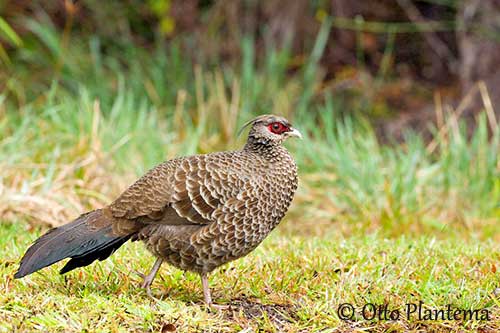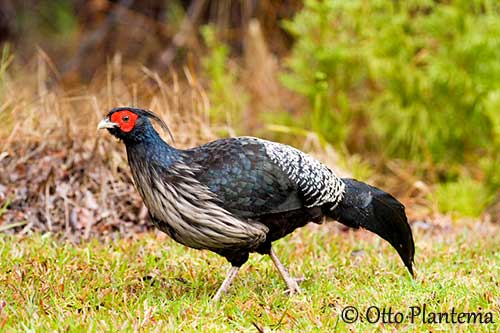
PROTECTION / THREATS / STATUS:
The Kalij Pheasant is not globally threatened, but the situation varies with each race. Declines are reported, due to habitat destruction and heavy hunting pressure. But currently, this species is evaluated as Least Concern by BirdLife International.
Fr: Faisan leucomèle
All: Kalifasan
Esp: Faisán Kálij
Ita: Fagiano di Kalij
Nd: Nepalfazant
Sd: Kalijfasan
Photographers:
Jean Michel Fenerole
Photos d’Oiseaux du monde
Otto Plantema
Trips around the world
Ingo Waschkies
Bird Photography
Text by Nicole Bouglouan
Sources:
HANDBOOK OF THE BIRDS OF THE WORLD Vol 2 by Josep del Hoyo-Andrew Elliot-Jordi Sargatal - Lynx Edicions - ISBN: 8487334156
A Field Guide to the Birds of South-East Asia by Craig Robson. New Holland Publishers. ISBN: 9781780090498
Hennache, A. & Ottaviani, M. (2005). Monographie des faisans, volume 1. Edition W.P.A. France, Clères, France. ISBN: 2-9512467-1-4
Hennache, A. & Ottaviani, M. (2006). Monographie des faisans, volume 2. Edition W.P.A. France, Clères, France.ISBN: 2-9512467-2-2
Les auteurs renoncent à leurs droits d'auteurs pour que la vente de cet ouvrage, publié par la World Pheasant Association, soit destinée à soutenir des projets de conservation.
BirdLife International (BirdLife International)
What Bird-The ultimate Bird Guide (Mitchell Waite)
Wikipedia, the free encyclopaedia
Kalij Pheasant
Lophura leucomelanos
Galliformes Order – Phasianidae Family
INTRODUCTION:
The Kalij Pheasant is a species of the Himalayan foothills where it occurs in forests and thickets. Closely related with the Silver Pheasant (Lophura nycthemera), they can hybridize.
Nine subspecies are recognized. The nominate race has been introduced into Hawaii in 1962, and its population is increasing regularly.
DESCRIPTION OF THE BIRD:
Biometrics:
Male: Length: 63-74 cm (tail: 21-35 cm)
Female: Length: 50-60 cm (tail 19-23 cm)
Weight: 564-1025 g
The adult male of nominate race has glossy blue-black plumage with purplish to greenish wash, and with distinctive broad white scales on lower back to uppertail-coverts. Wings and vent are blackish-brown and mostly glossless. The tail is glossy blue-black above and black below. The breast is grey to greyish-white, but there are many variations in breast colour according to the race, and extent of white pattern on lower back, rump and tail.
On the head, forehead, crown and throat are black, whereas the nape is glossy blue-black. We can see several elongated blue-black feathers, forming a long crest on the hind crown. The face shows bright red to scarlet wattles.
The bill is pale grey. The eyes are dark brown. Strong legs and feet are pale brown. We can see a spur at the rear of each tarsus.

The female has reddish-brown to dark brown plumage, with whitish-edged feathers giving scalloped appearance. The tail is black with chestnut-brown central rectrices. The flight feathers are brown.
The underparts are brown too, with buff to whitish shaft-streaks.
On the head, the red wattles are smaller than in male, mostly restricted to the eye area. The crest is shorter and brown.
The bill is horn-coloured with greenish tinge. The eyes are orange-brown. Legs and feet are similar to male but she lacks the spurs.
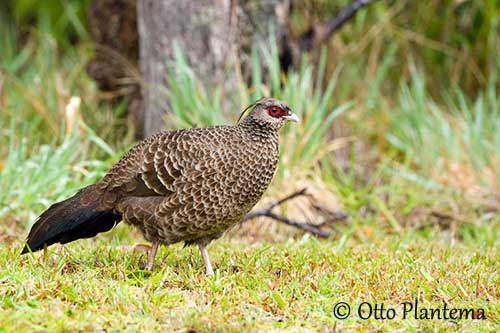
The juvenile is dark brown. On the underparts the feathers show white spot at tip, whereas on the upperparts, they have dark subterminal bar and buff edges. The adult plumage is visible at one year old.
SUBSPECIES AND RANGE:
There are 9 subspecies showing wide variations in male plumage, mainly in breast colour and extent of white pattern on lower back, rump and uppertail-coverts.
L.l. leucomelanos (here described) is found in W and EC Nepal. It has been introduced on Hawaii.
L.l. hamiltoni is found in W Himalayas, from R Indus A to W Nepal. This race shows white or very pale crest, broad whitish barring on rump, and brownish-white edges on underparts’ feathers. The female is brown with darker tail.
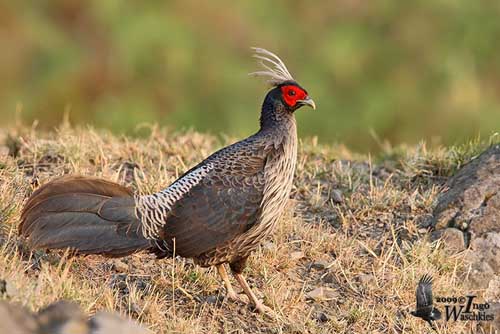
The other races:
L.l. melanota from NE India and W Bhutan. Introduced in SW Argentina in 1920.
L.l. moffiti from C Bhutan. This one is rarer.
L.l. lathami is found in E Bhutan and NE India.
L.l. williamsi from W Burma and possibly in NE India.
L.l. oatesi from S Burma, E of R Irrawaddy.
L.l. lineata is found in S Burma, E of R Irrawaddy S to W Thailand.
L.l. crawfordi from SE Burma and peninsular Thailand.
HABITAT:
The Kalij Pheasant can be found in a variety of habitat types such as evergreen and deciduous forests with dense undergrowth in valleys, or thickets, secondary vegetation and abandoned cultivated areas.
This species can be found from 25 metres in NE Bangladesh, up to 3700 metres in Nepal.
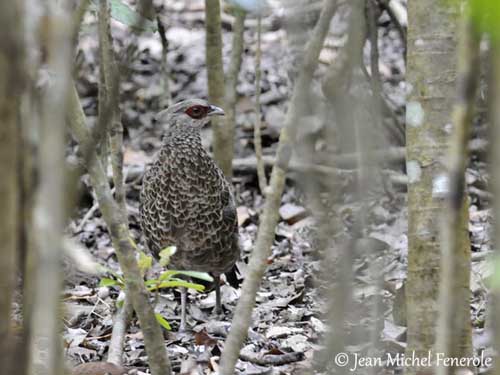
CALLS AND SONGS: SOUNDS BY XENO-CANTO
The Kalij Pheasant is mainly heard at dawn and dusk, uttering loud whistling chuckle or chirrup-like calls.
When disturbed, it produces guinea pig-like squeaks and chuckles, a rapid “WHiii WHiiii WHiiii” and a whistling “psee psee psee” when flushed.
BEHAVIOUR IN THE WILD:
Like numerous pheasants, the Kalij Pheasant is omnivorous. It feeds on diverse food items such as bamboo seeds, small snakes, termites, figs, forest yams, acorns, ripe fruits and other plant matter.
It usually forages in small groups of 10-20 birds, and sometimes in single-sex groups in Bhutan. They scratch the ground with their strong feet and dig with the bill for roots and tubers. They forage along tracks and roads, also in fields, in the early morning and late afternoon.
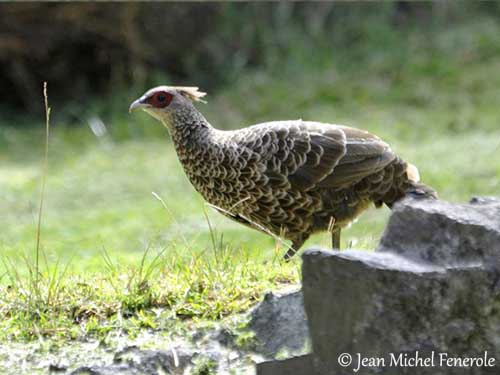
During the breeding season, the male performs the usual courtship displays. It also drums by flapping its half-open wings against its body. During the displays, both lateral and frontal, the plumage pattern is enhanced by spreading wings and tail. The wattles are bright red and inflated and the crest is erect. Calls and other sounds accompany these ritual displays.
The Kalij Pheasant is probably sedentary, only performing seasonal movements for food and water.
Although well known as mostly terrestrial bird, it can fly if frightened, but it is also a quick runner! It roosts in trees at night.
REPRODUCTION OF THIS SPECIES:
The breeding season varies with the races.
The nest-site is in thick undergrowth. The nest is a shallow depression on the ground, often near water. The scrape can be lined with leaves.
The female lays 6-9 creamy-white to reddish-buff eggs. Larger clutch is usually produced by more than one female. She incubates alone during 20-22 days, according to the range and the weather.
At hatching, the chicks are covered with brown to chestnut down above and whitish below. The male may participate in rearing the chicks once they have left the nest.
The mating system could be both monogamy and polygamy.
